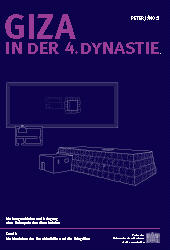Peter Jánosi
ist Ägyptologe an der Universität Wien
|
 |
In diesem (ersten) Band werden die Ergebnisse präsentiert, die basierend auf den Grabungsfunden der großen archäologischen Unternehmungen des 20. Jhds. (geleitet von G. A. REISNER, H. JUNKER, S. HASSAN und anderen) die Entstehungs- und Belegungsgeschichte der großen Nekropole von Giza während der 4. Dynastie behandeln.
Im ersten Teil der Untersuchung werden grundsätzliche Fragen der Datierung - die Möglichkeiten und Grenzen verschiedener Datierungsanwendungen, die speziell die Gräber in Giza betreffen - diskutiert. Der zweite Teil beschäftigt sich mit den einheitlich errichteten Mastabas der so genannten Kernfriedhöfe, also mit jenen Gräbern, die in genormter Bauweise für die Elite der damaligen Gesellschaft errichtet wurden. Im Vordergrund der Arbeit stehen die architektonischen und archäologischen Befunde der Mastabas und ihre Kultanlagen. Die Darlegung des Baugeschehens, die zeitliche Eingrenzung der Entstehung, Vollendung und Belegung der Gräber unter Cheops und später, nimmt den größten Teil der Arbeit ein. Der letzte Teil ist der Entstehung und Entwicklung der ältesten Felsgräber in Giza gewidmet.

…
Based on the results of the archaeological excavations conducted by G. A. Reisner, H. Junker, S. Hassan and others in the twentieth century, this (first) volume ventures to reconstruct the building history and the development of the private necropolis in Giza during the Fourth Dynasty. In the first section of the book, general problems concerning the dating of tombs are addressed and discussed. The second part deals with the mastabas of the so-called hub cemeteries erected for the elite under Khufu. In assessing the architecture and the archaeology of the tombs and their chapels, a chronological time frame has been established in which the beginning, the alterations and enlargements, the completion and finally the use of the tombs under Cheops and later is discussed. In the third part of the investigation, the rock-cut tombs that served as burial places for the princes and high officials are dealt with. The "sudden" appearance of this type of tomb marks a drastic deviation from traditional tomb building. The development of the architecture of the rock-cut tombs as well as their affect on tomb building in the following dynasties is thoroughly discussed. Special attention is devoted to the development of the offering chamber, which exhibits fundamental changes in the course of time. |





 Home
Home
 Print
Print
 References
References
 Share
Share
